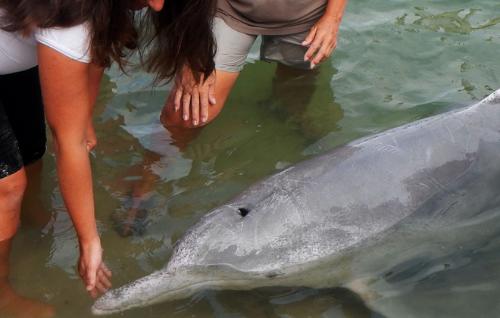Published in the Ocean Watch column, Honolulu Star-Advertiser © Susan Scott
November 3, 2014
Tin Can Bay, Queensland, Australia » Last week I visited one of the friendliest, most lovable families in Australia: the dolphins of Tin Can Bay.
Even if a group of Indo-Pacific dolphins hadn’t come to the shoreline each day to play with people and eat free fish, a visitor just has to stop at a place named Tin Can Bay. After putting my sailboat up for the cyclone season, I rented a car and drove to the cove.
Tin Can Bay is a fishing town of about 2,000 residents located in a deep, narrow inlet of the same name. The name has nothing to do with canned goods, but arose from the indigenous word “tuncanbar,” meaning dugong, another species that frequents the harbor’s calm water.
The dolphin phenomenon began in the 1950s when an injured male dolphin languished near a restaurant pier. Residents fed the animal, and after he recovered he remembered the kindness (and free food) and returned daily for a meal.
Eventually a female also came to the pier, and in 1991 she brought her baby. Today four dolphins from four generations arrive every morning at about 7 a.m. They have fun with people until 8 a.m. and then get one 6-inch-long fish from each person waiting in line for the privilege (about 30 when I was there).
Researchers restrict the number of fish the dolphins are given, making the feeding a light snack before a day of normal foraging.
Standing in the water with the dolphins costs $5, and another $5 buys a fish. The money supports research on the pod and supervision of human-dolphin interactions.
Cheerful volunteers had us turn off our ring tones and camera flashes and explained that touching is forbidden. As with most wildlife encounters, though, if the animal wants to touch you, that’s fine.
I waded knee-deep into the water, immersed my hand and waited. I was the first one there (surprise, surprise), and the exuberant 2-year-old, Squirt, nudged my hand with her snout. Then, ever so gently, she took my fingers between her long, narrow jaws. The thrill of feeling a wild dolphin’s roundish teeth on my hand will stay with me forever. I’m smiling just writing about it.
Some people don’t approve of this feeding and mingling, but I do. This mom, dad, daughter and auntie are ambassadors for all Indo-Pacific dolphins, a coastal and estuary species threatened by just about everything we humans do, from fishing to development to pollution.
To protect an animal we have to love it, and to love it we have to know it. Because of these special dolphins and their hospitable guardians, each day 30-some people from all over the world meet and fall in love with Indo-Pacific dolphins. It just may save them.
